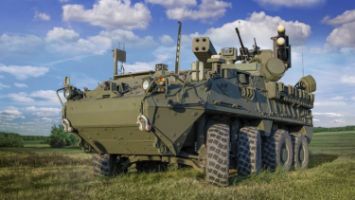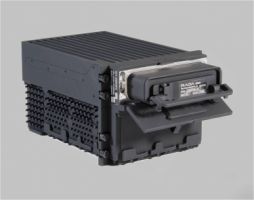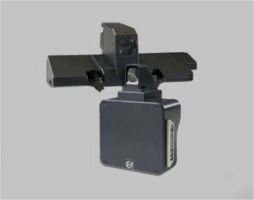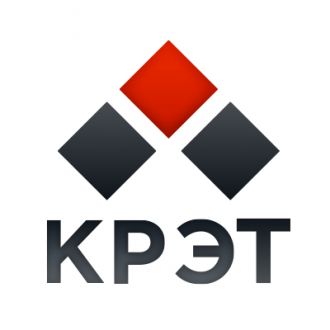
Categories
- Aircraft, Helicopter, UAV, Spacecraft & related equipment
- C4I, Communication Systems
- Electrical, Electronics & Electro-optics
- Radar, Sonar, Navigation, Targeting, Surveillance
A subsidiary of Leonardo DRS, DRS Rada Technologies focuses its activities on proprietary radar solutions and legacy avionics systems for customers around the world. The company is a global pioneer of mini-tactical radars for active military protection, counter-drone applications, critical infrastructure protection, and border surveillance.
A recognized pioneer of battle-proven, state-of-the-art mini-tactical radars
Supplying a global customer base that includes the armed forces of more than 30 countries, our advanced radars are deployed on hundreds of battle-platforms of the IDF, IAF, US Army, USMC, USAF, US SOF, and more.
We work closely with the world’s leading defense integrators such as Rafael Advanced Defense Systems, Elbit Systems, Israel Aerospace Industries (IAI), Lockheed Martin, Boeing, Leonardo DRS, Rheinmetall Air Defense, ELT, Hindustan Aeronautics Ltd (HAL), Embraer, and others.
All Threat Air-Surveillance Radars
RADA's All-Threat Tactical Air-Surveillance radar systems detect all types of aerial vehicles (including UAVs of all groups) and missiles, rockets and mortars. They classify the threats, provide and display tracking and warning/alert, and provide data to external C4I and air defense weapon systems over Ethernet, making them the ideal sensors for MANPAD, VSHORAD, SHORAD and tactical IAMD systems.
The radar systems can be based on any member of RADA's Multi-Mission Hemispheric Radar (MHR) family of tactical radar platforms - pMHR, eMHR, ieMHR - which differ primarily in antenna sizes, resulting in maximal detection ranges.
The MHR-based air surveillance radars are the system of choice for current and emerging tactical Integrated Air & Missile Defense weapon systems, whether based on guns, missiles, directed energy, or other threat defeat technologies. These tactical radar systems are also ideal gap-fillers, complementing medium and long-range air surveillance systems. The radars can work at any installation method: fixed, deployable/maneuverable, operate OTM onboard tactical land vehicles, or shipborne onboard littoral combat and patrol ships.
When radars are integrated with EO/IR sensors and RF jammers, this counter-UAV (C-UAV) system provides a complete "soft-kill" solution against nano, micro and mini-size drones.
A single radar platform provides 90º azimuth coverage using MHR and 120º using CHR.
Hemispheric coverage is achieved when four/three identical and interchangeable radars are employed as a system.
Key characteristics:
- Pulse Doppler, Software-Defined, Multi-Mission Radars Platforms
- AESA (Active Electronically Scanned Array) Antenna based on GaN Amplifiers
- Extremely High Elevation Angles, up to Hemispheric Coverage
- On-the-Move (OTM) Operation
- Non-Ratating, Solid State, Digital Radars
- Compact and Mobile, for Tactical Applications
- High Reliability
- Superior Performance-to-Price Ratio
Active Protection Solutions for Combat Vehicles
RADA’s Compact Hemispheric Radar (CHR) detects, tracks and classifies all relevant threats that may be fired at combat vehicles – RPGs, ATGMs, and tank rounds. When three or four radars are connected as a system, they provide hemispheric coverage to the Armored Fighting Vehicle (AFV) on which they are installed.
This software-defined radar platform, in its RPS-10 mission, is the core sensor for advanced Active Protection Systems (APS). It provides the real-time target trajectory data to the APS at ranges and accuracies which enable automatic and precise interception and neutralization of the threat. Integration with any APS and/or Battle Management System (BMS) is enabled thru the CHR’s standard Ethernet channel.
When the CHR is integrated with Laser Jammers and/or immediate smoke grenades launching system, this RSK-51 system provides Soft-Kill active protection solution against ATGMs.
In addition to target track data, the CHR computes the firing point and impact point of the fired threats, at tactical accuracies.
The CHR’s armored-steel antenna provides resistance to bullets and fragments of the radar and its electronics.
In addition to APS solutions, the CHR software-defined platform can host a variety of operational missions such as Hostile Fire Location, Ground/Surface Surveillance, and combinations of such operational missions.
Key characteristics of the CHR Patform:
- Pulse Doppler, Software-Defined Radars
- AESA (Active Electronically Scanned Array) Antenna based on GaN Amplifiers
- Extremely High Elevation Angles, up to Hemispheric Coverage
- On-the-Move (OTM) Operation
- Non-Ratating, Solid State, Digital Radar
- Compact and Mobile, for Tactical Applications
- High Reliability
- Superior Performance-to-Price Ratio
Hostile Fire Location Radar Systems
RADA’s Hostile Fire Detection (HFD) and Location radar systems detect, track, classify and locate all types of direct and elevated fires, including: Rockets, Artillery, Mortars (RAM), ATGMs, RPGs, Low-QE Rockets, Small Arms, and more. They classify the threats, calculate the POO (point of origin) and POI (point of impact) with tactical accuracies, display tracking and provide audible and visual warning/alert, as well as data over Ethernet to external C4I systems for alerting the threatened forces.
The radar systems can be based on any member of RADA’s Multi-Mission Hemispheric Radar (MHR) family of tactical radar platforms – pMHR, eMHR, ieMHR, and also the Compact Hemispheric Radar (CHR) platform. These radar platforms differ primarily in antenna sizes, resulting in maximal detection ranges.
These Hostile Fire Location radars are the systems of choice for advanced tactical force protection and C-RAM solutions, whether on-the-move or stationary. They provide maximal alert time against elevated fire, and accurate POO for preventing further threats coming from the same firing origin.
The radar systems can be integrated with any protection system and other radars/sensors. It may be installed onboard fighting vehicles for deployable, on-the-move force protection, at fixed bases, and also shipborne onboard littoral combat and patrol ships.
A single radar platform provides 90º azimuth coverage using MHR and 120º using CHR.
Hemispheric coverage is achieved when four/three identical and interchangeable radars are employed as a system.
Key characteristics:
- Pulse Doppler, Software-Defined, Multi-Mission Radars Platforms
- AESA (Active Electronically Scanned Array) Antenna based on GaN Amplifiers
- Extremely High Elevation Angles, up to Hemispheric Coverage
- On-the-Move (OTM) Operation
- Non-Ratating, Solid State, Digital Radars
- Compact and Mobile, for Tactical Applications
- High Reliability
- Superior Performance-to-Price Ratio
Three-Dimensional Perimeter Surveillance Radars
RADA's Three-Dimensional (3D) Perimeter Surveillance Radars provide comprehensive border and perimeter surveillance through detection, classification and tracking of surface and aerial intruders such as pedestrians, vehicles, slow and small aircraft, vessels and more.
These radar systems can be based on any member of RADA’s Multi-Mission Hemispheric Radar (MHR) family of tactical radar platforms – pMHR, eMHR, ieMHR, and also the Compact Hemispheric Radar (CHR) platform. These radar platforms differ primarily in antenna sizes, resulting in maximal detection ranges.
RADA's 3D Perimeter Surveillance Radar Systems are the systems of choice for borders, coasts and critical infrastructure protection solutions. These radar systems can be integrated with any C4I system and other radars/sensors using its standard Ethernet interfaces, and can operate stand-alone or as part of a large-scale surveillance system, vehicle-mounted or static.
A single radar platform provides 90º azimuth coverage using MHR and 120º using CHR.
Hemispheric coverage is achieved when four/three identical and interchangeable radars are employed as a system.
Key characteristics:
- Pulse Doppler, Software-Defined, Multi-Mission Radars Platforms
- AESA (Active Electronically Scanned Array) Antenna based on GaN Amplifiers
- Extremely High Elevation Angles, up to Hemispheric Coverage
- On-the-Move (OTM) Operation
- Non-Ratating, Solid State, Digital Radars
- Compact and Mobile, for Tactical Applications
- High Reliability
- Superior Performance-to-Price Ratio
ISR Mission Aircraft Upgrades
RADA's cost-effective ISR Mission Aircraft upgrade suite is tailored to:
- Detection of hostile and illegal activities in real-time and thru post mission analysis
- Airborne command and control of multi-force threat neutralization operations
The ISR mission aircraft operates in all weather, day and night conditions and is effective for adverse terrain (rainforests, mountains and alike).
RADA's ISR Mission Aircraft is accompanied by a ground infrastructure that provides mission planning, post-mission data analysis and data archiving. It can be networked with any existant command and control station.
Based on extensive system engineering expertise, complex programs management skills and a wide range of indigenous core avionics systems, RADA offers scalable and highly affordable solutions which are tailored to each customer's needs in extremely short periods.
Avionics Upgrades | Advanced Avionics Upgrades for Trainers and Fighters
RADA's advanced, scalable and affordable Avionics Upgrade Package is the ultimate solution for new or ageing light fighter or advanced trainer aircraft. RADA offers complete, proven and operational avionics suits, from mission & display computer thru all needed sensors and displays, and up to post-flight ground debriefing stations.
RADA's core package is based on the Israeli Air Force (IAF) A-4 avionics upgrade program which was integrated and supplied to the IAF in record times.
Based on extensive system engineering expertise, complex programs management skills and a wide range of indigenous core avionics systems, RADA offers scalable and highly affordable solutions which are tailored to each customer's needs in extremely short periods.
Avionics for MALE/HALE UAVs
RADA offers a wide spectrum of avionics products, optimized to the requirements of Medium Altitude Long Endurance (MALE) and High Altitude Long Endurance (HALE) Unmanned Aerial Vehicles (UAVs).
The uniqueness of RADA's family of Avionics for UAVs:
- Extremely compact through modern board connectivity solutions
- Innovative conductive cooling techniques
- Withstanding extreme environmental conditions
- Very high reliability
- Affordability
RADA offers the entire family of core avionics units, from power distribution and engine electronic control, thru sensors and payloads management, up to flight control, mission management and inertial navigation systems. Our solutions are easily adaptable to specific customer requirements for all types of UAV and user requirements. Units are offered as complete solutions (hardware and software), or as hardware and basic software packages that enable customers to develop their own operational software applications.
RADA's Military off the Shelf (MOTS) UAV avionics solutions are proven, operational and fully qualified military environmental conditions.
Provided to world leading Unmanned Aerial Systems (UAS) manufacturers, the systems are globally supported by our professional logistic support services.
MAVINS | Mini/Micro UAVs Avionics and INS
The MAVINS is an all-in-one, dual-redundant yet extremely compact avionics system-in-a-box, providing a complete core-avionics solution for Mini and Micro Unmanned Aerial Vehicles (UAV), and back-up solutions for manned platforms. It incorporates MEMS -based sensors, GPS receivers, powerful processors and extended interfaces, to facilitate platform autopilot, mission management, navigation functions and payload control applications.
MAVINS can perform in any combination of the following core-avionics capabilities:
- Autopilot – Computations and flight surfaces control (PWM)
- Mission Management and Control
- Inertial Navigation – full solution, AHRS sub-functionalities
- Air Data Center (ADC)
- Magnetometer
- Payloads and Data-link Control through extended I/O
VRDS | Video Recorder & Data Server System
RADA's Video Recorder & Data Server System (VRDS) introduces the cutting edge approach to video and data recording and mass-storage management onboard combat platforms of all kinds. The basic, powerful functions of video, audio and multiple data sources recording are empowered by mass storage management, powerful processing and extremely fast distribution of data over Gigabit Ethernet channels. This entire set of features is provided within a single unit, form and fit to the widely-used DTE, installed in cockpits of various types of fighters.
The VRDS advanced data server functions enable any avionics client onboard the platform to quickly write to or retrieve data from the mass memory, facilitating advanced capabilities with today's avionics, involving mass data processing. It records up to six video channels, two audio channels, MIL-STD-1553 Mux-Bus data, and Gigabit Ethernet data - all tagged with precise time for post-mission synchronized debriefing.
The system supports two video playback outputs. VRDS' Removable Mass-Memory Unit (RMU) can store up to 128 Gbytes of flash memory, and implements an autonomous secure-erase mechanism. Video recording rates are configurable per channel, and can vary from 1 to 15 megabits/sec. The combination of recording rates settings and RMU capacity provides compliance solution to any practical mission recording time requirement.
RADA's VRDS is qualified to cockpit military environment, and is accompanied by RADA’s family of Ground Debriefing Solutions (GDS) displaying synchronized playback of the recorded video, audio and data along with ACMI displays.
Advantages
- Powerful processing, embedding the MPC8548 PowerQuicc-IIICPU
- Handling of all analog video formats
- MPEG-4 (H.264) video compression
- Incorporation of audio recording on each video stream
- Real time playback of 2 video channels
- Data server functions, centralized source of mass-memory
- High-speed Gigabit Ethernet interface channels
- Incorporation of DTS/DTE functionalities
- Large RMU capacity - up to 128GBytes of flash memory
- Advanced, autonomous secure-erase features
DVDR | Digital Video & Data Recorder
RADA's Digital Video & Data Recorder (DVDR) is the replacement-of-choice to the ageing and near-obsolete commonly used analog video tape recorders. Form and fit to all common airborne analog recorders, DVDR has become the replacement of choice for airborne video tape recorders. Introducing new performance and functionality levels DVDR is taking recording and debriefing abilities to new heights. The basic, powerful functions of DVDR include video and audio recording, empowered by data synchronized recording of various sources, real-time playback, and mass storage management.
The DVDR records up to six video channels, two audio channels, up to three MIL-STD-1553 Mux-Bus data, and Fast Ethernet data - all stamped with precise time for post-mission synchronized debriefing. The system supports two video playback outputs. It can be installed in a cockpit (as a form and fit replacement to a common, single-channel analog recorder), or – in conjunction with an adapting tray – in an equipment bay (as a form and fit replacement to a common, analog, three-tapes deck). DVDR’s Removable Mass-Memory Unit (RMU) stores up to 128 Gbytes of flash memory, and implements a secure-erase mechanism. Video recording rates are configurable per channel, and can vary from 1 to 15 megabits/sec. The combination of recording rates settings and RMU capacity provides compliance with any practical mission recording time requirement.
RADA's DVDR is qualified to the harshest military environment, and is operational onboard numerous Western and Eastern manned aircraft across the globe.
The DVDR is accompanied by RADA’s family of Ground Debriefing Solutions (GDS) displaying synchronized playback of the recorded video, audio and data along with ACMI displays.
Advantages
- Handling of all analog video formats
- MPEG-2 or MPEG-4 (H.264) video compression
- Incorporation of audio recording on each video stream
- Real time playback
- Data server functions, centralized source of mass-memory
- Fast Ethernet interface channels
- Incorporation of DTS/DTE functionalities
- Large RMU capacity - up to 128GBytes of flash memory
- Advanced, autonomous secure-erase features
GDS | Ground Debriefing System
RADA's Ground Debriefing Systems (GDS) provides the ground segment supporting mission debriefing and air-combat exercises. GDS simultaneous, synchronized recording and playback of numerous digital channels, carrying audio and video from multiple sources. The system supports specialty features such as simulation and analysis tools for mission debriefing, and military unit data management.
Utilizing COTS based PC technology GDS is designed for advanced squadron level post-flight debriefing. RADA is also offering a GDS version embedded in a laptop PC, supporting field deployable applications. The system combines the digital video, audio and Air Combat Maneuvering Instrumentation (ACMI) data recorded on Removable Memory Modules (RMM) retrieved from each airborne Digital Video Recorder (DVR) processing a computer generated display of all aircraft that participated in the exercise. All digital video, audio and ACMI data from all participants are automatically and continuously synchronized by the GDS.
As RADA's missions recorders automatically tap information directly from the aircraft avionics bus, its mission debriefing capability provides a high level of synchronization, timing and details exceeding those provided by external ACMI pods. Furthermore, as an integral part of the digital recording system, RADA's ACMI solutions offers an affordable, sophisticated debriefing solution fielded throughout the entire fleet, supporting all missions flown.
EyeWitness | HCVC - HUD Color Video Camera
With over 1,500 units globally installed, RADA’s “EyeWitness” HUD Color Video Camera (HCVC) is an advanced, widely-used and highly affordable Military-off-the-Shelf (MOTS) family of products. This mature camera is designed to fit any Head-Up Display (HUD) which is currently operational in fighter aircraft cockpits.
The HCVC captures the image of the HUD symbology superimposed over the outside world view, as seen by the pilot during the mission. The color video signal produced by HCVC is recorded in-flight and used for post-flight ground debriefing.
The “EyeWitness” HCVC is installed on the HUD mechanical frame: either between the pilot’s eyes and the HUD combiner, or beyond the HUD combiner. In the latter installation position, the HUD symbology is superimposed over the camera video by the aircraft Display Processor prior to recording.
“EyeWitness” cockpit cameras employ CCD technology to produce perfect images through high video quality, while their Field-of-View (FOV) is designed for capturing the whole HUD display. The HCVCs are highly reliable and are qualified to cockpit military environment.
Advantages
- High-resolution color image
- Wide dynamic range
- Synchronization to external sync.
- Built-in Event Mark
- Easily adaptable to existing HUDs
- Standard NTSC or PAL video formats
- Compact, lightweight and reliable
R-100F | FOG-Based Embedded GPS/INS (EGI)
The R-100F is a high performance, navigation-grade Inertial Navigation System, based on advanced Fiber Optic Gyro (FOG) technology. It integrates navigation sensors with an embedded 16-channels CA-code GPS receiver and provides independent INS-only and blended INS/GPS solutions.
RADA's navigation solutions introduce sophisticated and unique sensor fusion algorithms, and embed modular design principles leading to minimal integration efforts into larger mission systems.
The R-100F characteristics and performance make it suitable for a broad spectrum of INS applications, including mission control and flight control systems. The system is qualified to military environment.
Advantages:
- Advanced FOG sensor technology
- Three independent navigation solutionWASS, EGNOS, MSAS and Galileo - Ready
- INS Only
- Blended INS/GPS
- GPS Only
- WASS, EGNOS, MSAS and Galileo - Ready
- Steering calculations for various coordinate systems and datum
- Powerful Interface capabilities
- Low weight and volume
- High Reliability
R-200M | MEMS-Based Inertial Navigation System
The R-200M is an extremely compact, highly reliable and affordable Inertial Navigation System (INS), embedding inertial MEMS sensors, 16-channel GPS, air pressure sensors and magnetic heading sensor, providing multi-sensor aided navigation solution.
RADA's navigation solutions introduce sophisticated and unique sensor fusion algorithms, and embed modular design principles leading to minimal integration efforts into larger mission systems.
The characteristics and performance of the R-200M make it suitable for a broad spectrum of inertial data applications in Unmanned Aircraft Systems (UAS) and weapon systems, as a full INS solution, as Attitude and Heading Reference System (AHRS), as data source for stabilization functions onboard such combat platforms, and other utilizations. The system is qualified for military environment.
Advantages:
- Calibrated low-cost MEMS sensors
- High accuracy INS data in blended INS/GPS mode
- Accurate attitude data with baro aiding (for non-GPS navigation)
- Stable INS data during GPS outages
- Low weight and volume
- High Reliability and affordability
Customers
RADA Electronic Industries' customers list include
- Lockheed Martin
- Boeing
- General Electric
- HAL
- Embraer
- IAI
- Rafael
- Elbit Systems
- and many others
DRS Rada Technologies Ltd.
- 7 Giborei Israel Blvd.,Gate A Level 1, P.O. Box 8606, 42504, Netanya, Israel
- +972 9 8921111
- +972 9 8855885
- mrkt@rada.com
- www.drsrada.com/














